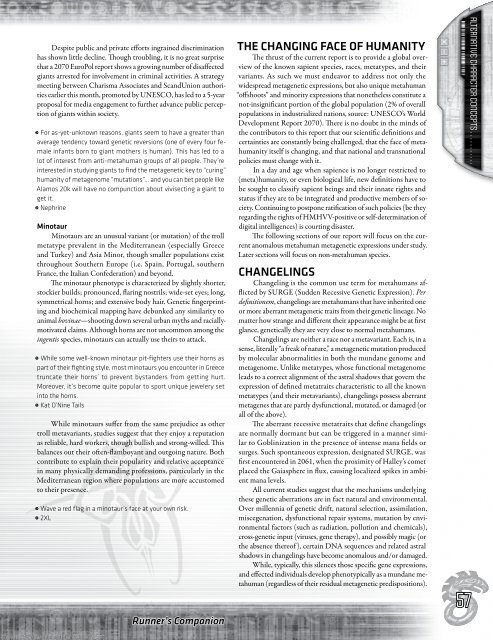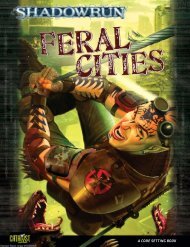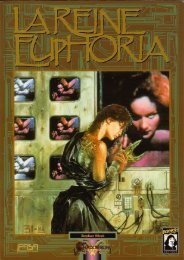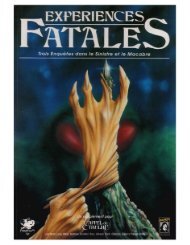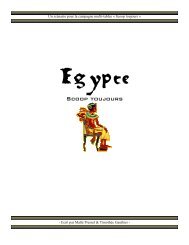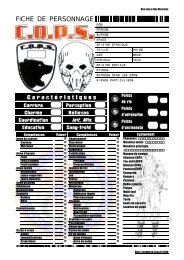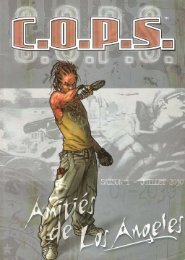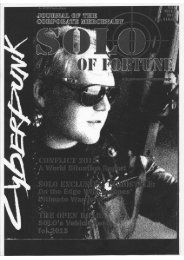Runner's Companion.pdf - Free
Runner's Companion.pdf - Free
Runner's Companion.pdf - Free
- No tags were found...
Create successful ePaper yourself
Turn your PDF publications into a flip-book with our unique Google optimized e-Paper software.
Simon Wentworth (order #1132857) 9Despite public and private efforts ingrained discriminationhas shown little decline. Though troubling, it is no great surprisethat a 2070 EuroPol report shows a growing number of disaffectedgiants arrested for involvement in criminal activities. A strategymeeting between Charisma Associates and ScandUnion authoritiesearlier this month, promoted by UNESCO, has led to a 5-yearproposal for media engagement to further advance public perceptionof giants within society.> For as-yet-unknown reasons, giants seem to have a greater thanaverage tendency toward genetic reversions (one of every four femaleinfants born to giant mothers is human). This has led to alot of interest from anti-metahuman groups of all people. They’reinterested in studying giants to find the metagenetic key to “curing”humanity of metagenome “mutations”… and you can bet people likeAlamos 20k will have no compunction about vivisecting a giant toget it.> NephrineMinotaurMinotaurs are an unusual variant (or mutation) of the trollmetatype prevalent in the Mediterranean (especially Greeceand Turkey) and Asia Minor, though smaller populations existthroughout Southern Europe (i.e. Spain, Portugal, southernFrance, the Italian Confederation) and beyond.The minotaur phenotype is characterized by slightly shorter,stockier builds; pronounced, flaring nostrils; wide-set eyes; long,symmetrical horns; and extensive body hair. Genetic fingerprintingand biochemical mapping have debunked any similarity toanimal bovinae—shooting down several urban myths and raciallymotivatedclaims. Although horns are not uncommon among theingentis species, minotaurs can actually use theirs to attack.> While some well-known minotaur pit-fighters use their horns aspart of their fighting style, most minotaurs you encounter in Greecetruncate their horns’ to prevent bystanders from getting hurt.Moreover, it’s become quite popular to sport unique jewelery setinto the horns.> Kat O’Nine TailsWhile minotaurs suffer from the same prejudice as othertroll metavariants, studies suggest that they enjoy a reputationas reliable, hard workers, though bullish and strong-willed. Thisbalances out their often-flamboyant and outgoing nature. Bothcontribute to explain their popularity and relative acceptancein many physically demanding professions, particularly in theMediterranean region where populations are more accustomedto their presence.> Wave a red flag in a minotaur’s face at your own risk.> 2XLRunner’s <strong>Companion</strong>The changing Face of humanityThe thrust of the current report is to provide a global overviewof the known sapient species, races, metatypes, and theirvariants. As such we must endeavor to address not only thewidespread metagenetic expressions, but also unique metahuman“offshoots” and minority expressions that nonetheless constitute anot-insignificant portion of the global population (2% of overallpopulations in industrialized nations, source: UNESCO’s WorldDevelopment Report 2070). There is no doubt in the minds ofthe contributors to this report that our scientific definitions andcertainties are constantly being challenged, that the face of metahumanityitself is changing, and that national and transnationalpolicies must change with it.In a day and age when sapience is no longer restricted to(meta)humanity, or even biological life, new definitions have tobe sought to classify sapient beings and their innate rights andstatus if they are to be integrated and productive members of society.Continuing to postpone ratification of such policies (be theyregarding the rights of HMHVV-positive or self-determination ofdigital intelligences) is courting disaster.The following sections of our report will focus on the currentanomalous metahuman metagenetic expressions under study.Later sections will focus on non-metahuman species.ChangelingsChangeling is the common use term for metahumans afflictedby SURGE (Sudden Recessive Genetic Expression). Perdefinitionem, changelings are metahumans that have inherited oneor more aberrant metagenetic traits from their genetic lineage. Nomatter how strange and different their appearance might be at firstglance, genetically they are very close to normal metahumans.Changelings are neither a race nor a metavariant. Each is, in asense, literally “a freak of nature,” a metagenetic mutation producedby molecular abnormalities in both the mundane genome andmetagenome. Unlike metatypes, whose functional metagenomeleads to a correct alignment of the astral shadows that govern theexpression of defined metatraits characteristic to all the knownmetatypes (and their metavariants), changelings possess aberrantmetagenes that are partly dysfunctional, mutated, or damaged (orall of the above).The aberrant recessive metatraits that define changelingsare normally dormant but can be triggered in a manner similarto Goblinization in the presence of intense mana fields orsurges. Such spontaneous expression, designated SURGE, wasfirst encountered in 2061, when the proximity of Halley’s cometplaced the Gaiasphere in flux, causing localized spikes in ambientmana levels.All current studies suggest that the mechanisms underlyingthese genetic aberrations are in fact natural and environmental.Over millennia of genetic drift, natural selection, assimilation,miscegenation, dysfunctional repair systems, mutation by environmentalfactors (such as radiation, pollution and chemicals),cross-genetic input (viruses, gene therapy), and possibly magic (orthe absence thereof ), certain DNA sequences and related astralshadows in changelings have become anomalous and/or damaged.While, typically, this silences those specific gene expressions,and effected individuals develop phenotypically as a mundane metahuman(regardless of their residual metagenetic predispositions).57alternative character concepts . . . . . . . . . . .


